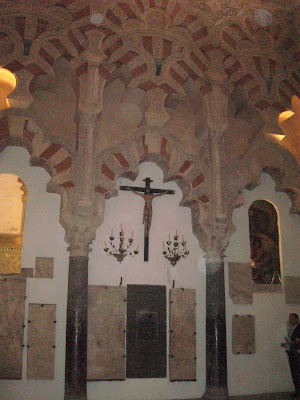
Ah! The great outdoors! This daytrip was certainly a highlight of the entire trip. I love nature.

The highest peak of continental Spain (Mulhacén) is in the Sierra Nevada mountain range. Apparently, the snow lingers till midyear, making it a popular destination for skiing. (It is the southernmost ski resort.) And for other sports like hiking and mountain biking as well.

It was a glorious day when we were up there. If the photos don't tell the same story, it's totally 'cos I'm a lousy photographer with my basic digital camera. We had a fantastic day not just 'cos it was great to escape into nature, but also 'cos we had a very entertaining guide - Shane - and his 1997 Land Rover Defender 101. More of the antics of the pair later on.

The ski resort was still in operation. The higher we drove, the colder it got. My thin sweater was not enough. Even Shane felt cold. This man-of-the-wild had spent 3 years as a guide in the Amazon. Yeah, that one in Peru. He talked rapidly (and often) and exuded a nervous energy, which he attributed to the Greek blood in him. Clearly an environmentalist, he had extensive knowledge of the great range of flora and fauna in the Sierra Nevada. He'd stop the jeep by the road and pluck a berry and tell us that this was where the natives got their vitamin I-forgot-which from.

Lovely bloom. You know, the thing I enjoy most in nature is the absolute peace and quiet. Up in the mountain, one does not hear the "background noise" (i.e. traffic, construction etc.) of a city (or you can call it city sounds). Instead, you hear nothing but the sound of wind blowing. And I mean nothing. That sense of tranquility is indescribable. It is something you'd never get in a city, even in the dead of the night.

As I was saying, this daytrip up in the mountain was memorable not just 'cos of the nature, but also 'cos of Shane and his jeep. Here's why:
1) A few minutes up the mountain, his Land Rover started smoking. Apparently one of the pipes had burst. So all along the journey, he had to collect water from rivers/streams to cool the engine.
2) A good half hour into the journey after lunch (with photo stops along the way), Shane discovered that he was missing his (expensive) binoculars. Couldn't find it after ransacking his jeep and backpack. We saw how flustered he was and urged him to retrace our route in search of his binoculars.
3) So he left us at a hiking station, promising to be back within half hour or so. We didn't mind at all 'cos it was nice to be able to walk around and take in the fresh air (there was a group of students doing some outdoor activities nearby). Besides, the weather was glorious. So we chatted, strolled around, stood around, took photos and waited. And waited. Our dear guide didn't show up till nearly 3 hours later. We were playing "Spot the green jeep" and thought that as long as the sun didn't set, we were ok. If so, we'd just run (ok, walk) down the hill to the nearby restaurant. Good thing was Shane did find his binoculars...at the restaurant where we had lunch (a good lunch if I may add).
4) The road leading up to the hiking spot was narrow, so Shane had to make a 3-point turn somewhere to head out. He chose a swamp. And just as he uttered the words "...I hope we don't get stuck in the mud...", we got stuck in the mud. So much for a Land Rover. He tried to engage the right gears but nothing seemed to work. Then he took out the vehicle handbook which we thought was hilarious.
5) One of the tires was stuck in the mud, but it wasn't in deep at all. After trying for about 15 minutes, the jeep remained stuck. Then, something we needed came along - an English family. After the unavoidable joke about an English Land Rover being stuck in mud, the family (with 3 well-behaved kids) literally got themselves dirty to help us. Half hour later, the jeep finally inched out. We all clapped and cheered like Taiwanese passengers when a plane lands (why do they do that?). Their minivan pulled the jeep out of the mud, but only after putting debris beneath the tires for traction (see, I learnt something that day). Seriously, we were very thankful for the helpful family, who really went out of their way to help us. Even their kids contributed.
6) And to top it off, we weren't even supposed to go to the Sierra Nevada. We'd signed up for a daytrip to Las Alpujarras, which was a town in the Sierra Nevada. Didn't realize it till lunch. Goes to show that a mistake can be a good thing.



















































